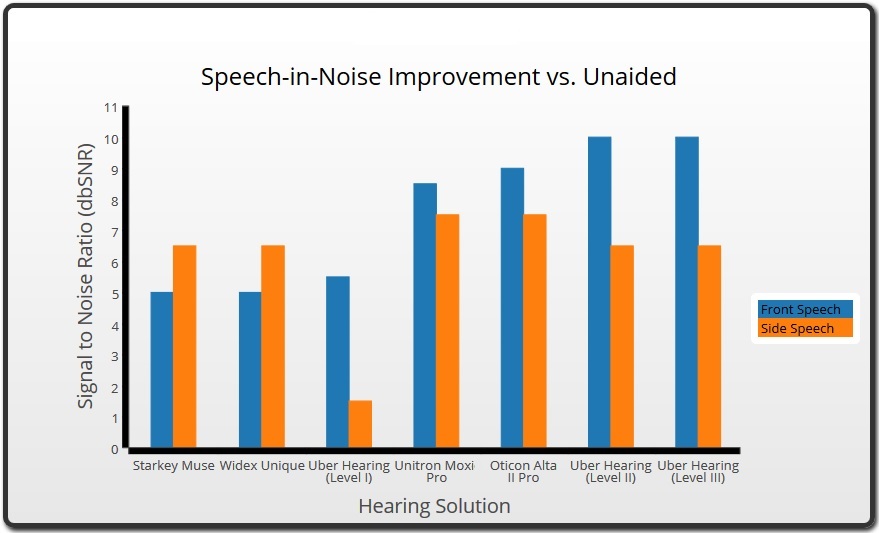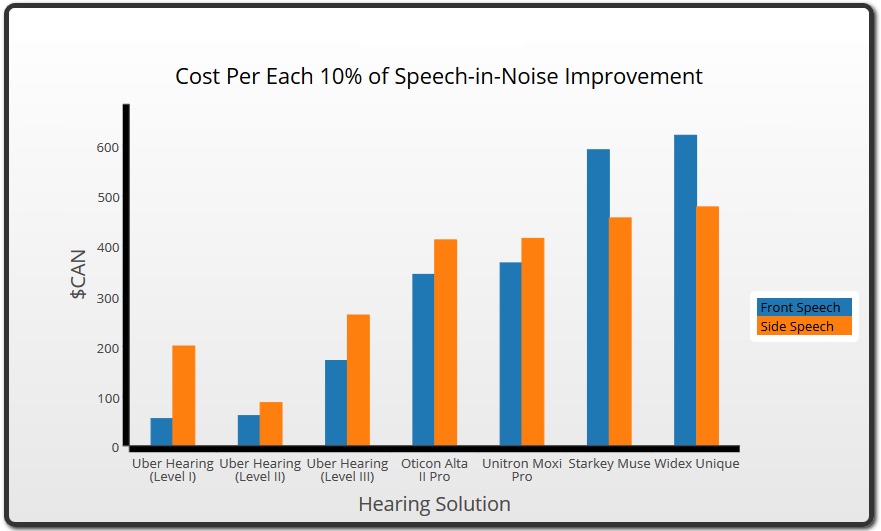Compare Hearing Aids
How do UBHearing™ aids compare with hearing aids or solutions offered by different manufacturers and clinics?
We've recently completed clinical testing*** of the speech-in-noise capabilities of our UBHearing™ hearing aids as well as the most popular top-of-the-line devices from various other manufacturers. There's no doubt that, according to hearing aid consumers, the single most important aspect of a hearing aid is its ability to process speech-in-noise. Studies show that for each increase in 1 dbSNR (Signal-to-Noise Ratio), the hearing aid wearer is able to process 10% more desired speech in noisy environments.
We've recently completed clinical testing*** of the speech-in-noise capabilities of our UBHearing™ hearing aids as well as the most popular top-of-the-line devices from various other manufacturers. There's no doubt that, according to hearing aid consumers, the single most important aspect of a hearing aid is its ability to process speech-in-noise. Studies show that for each increase in 1 dbSNR (Signal-to-Noise Ratio), the hearing aid wearer is able to process 10% more desired speech in noisy environments.
How did UBHearing™ hearing aids fare?
We're proud to report that both our Level II and Level III hearing aids outperformed all other hearing aids tested in the Front Facing Speech Test. Our Level I product held its own by offering more improvement in noise than top-of-the-line Starkey Muse i2400 and Widex Unique 440 products in the Front Facing Speech Test.
When considering value, all UBHearing™ hearing aid solutions beat the competition, hands down. Compare our cost per 10% speech-in-noise improvement of $54 to $169 with the competition's cost of $342 to $620. The hearing aid offering the best value, based on these test results, is our Level II product which offers the highest speech-in-noise improvement (Front Speech) at a low cost of $60 per 10% improvement. Now that's value!
*Results represent both front facing and 90-degree SNR improvement with various hearing aids in sound booth using soundfield. All hearing aids programmed to NAL-NL2 targets using REM speech mapping. All hearing aids set to maximum speech-in-noise and noise reduction capability with the highest occluding generic domes available for each hearing aid. For all hearing aids speech-in-noise software options were chosen that yielded the best results for this specific test. All test subjects were fit binaurally. Test subjects had normal hearing and all audiograms were set to flat 40 dbHL loss bilaterally. All testing performed with 60 dbSPL speech signals with varying speech frequency noise from directly behind (for Front Speech test) or 90-degrees to one side (for Side Speech test) and QuickSIN sentences were used. Results reflect SNR improvement from the unaided measurements.
We're proud to report that both our Level II and Level III hearing aids outperformed all other hearing aids tested in the Front Facing Speech Test. Our Level I product held its own by offering more improvement in noise than top-of-the-line Starkey Muse i2400 and Widex Unique 440 products in the Front Facing Speech Test.
When considering value, all UBHearing™ hearing aid solutions beat the competition, hands down. Compare our cost per 10% speech-in-noise improvement of $54 to $169 with the competition's cost of $342 to $620. The hearing aid offering the best value, based on these test results, is our Level II product which offers the highest speech-in-noise improvement (Front Speech) at a low cost of $60 per 10% improvement. Now that's value!
*Results represent both front facing and 90-degree SNR improvement with various hearing aids in sound booth using soundfield. All hearing aids programmed to NAL-NL2 targets using REM speech mapping. All hearing aids set to maximum speech-in-noise and noise reduction capability with the highest occluding generic domes available for each hearing aid. For all hearing aids speech-in-noise software options were chosen that yielded the best results for this specific test. All test subjects were fit binaurally. Test subjects had normal hearing and all audiograms were set to flat 40 dbHL loss bilaterally. All testing performed with 60 dbSPL speech signals with varying speech frequency noise from directly behind (for Front Speech test) or 90-degrees to one side (for Side Speech test) and QuickSIN sentences were used. Results reflect SNR improvement from the unaided measurements.


